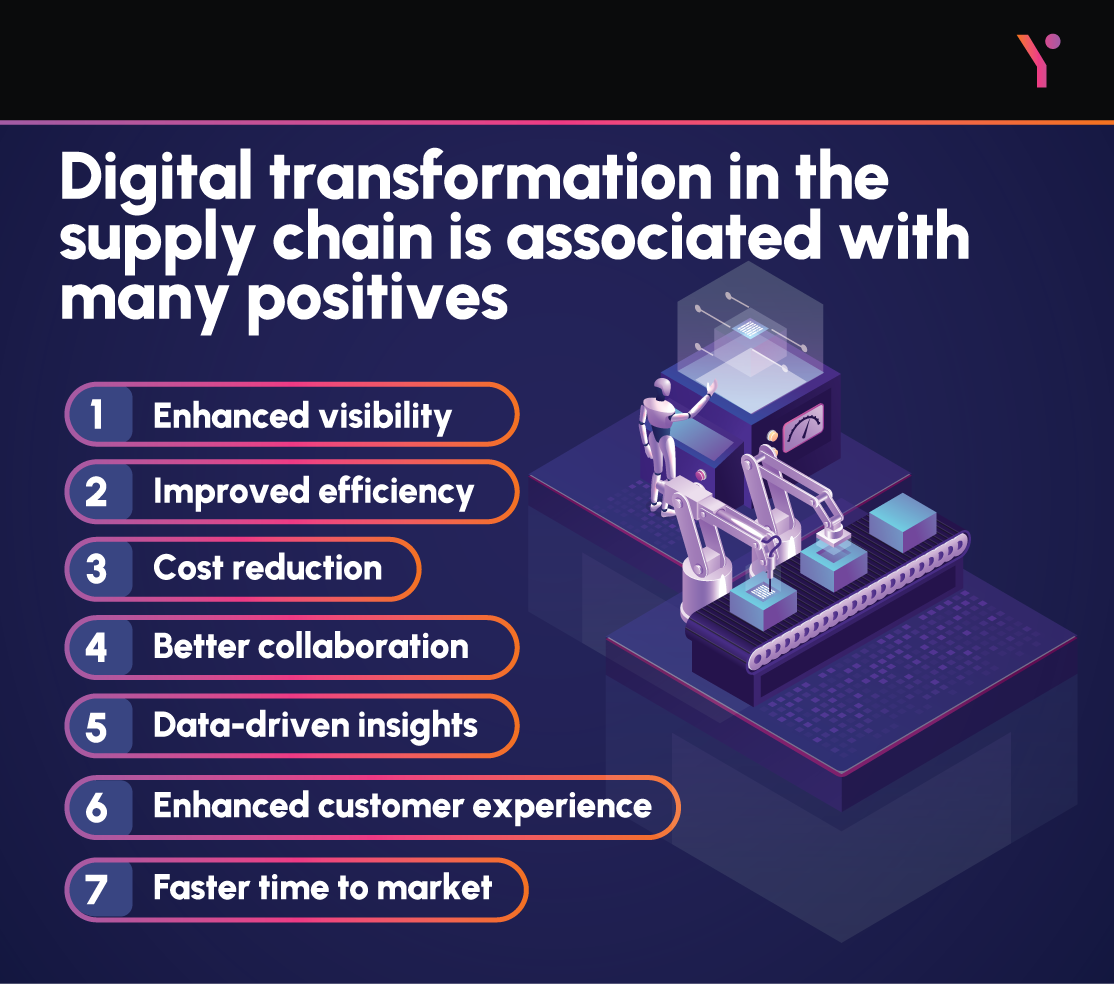Introduction
This blog will discuss the following points
You can look at almost any type of business throughout the world. It is quite evident that individuals who are responsible for supply chain management have become more and more prominent. This has been due to the fact that there have been shifting customer demands, economic uncertainty, product shortages, and new regulations associated with supply chain sustainability. Today, organizations need more than just visibility regarding what their customers and suppliers are up to. Here, they demand real-time and extended view into the customers’ customers and even the suppliers’ suppliers.
As Chief Information Officers across the board are seeking to upgrade or perhaps overhaul their organization’s supply chain management systems, some of their priorities are to increase data access, utilize data analytics to enhance the planning process, speed up goods delivery, and raise the supply chain capacity. In light of this, research has been conducted by the Center for Transportation and Logistics at MIT. This research found that digital transformation in supply chain can increase revenue by around 20% and also slash process costs in half.
On a side note, while you are on this topic, feel free to look into some other interesting topics, such as mobile web development or learning management software.
Defining Digital Transformation
It is important to set the records straight here. Digital transformation calls for the integration of digital technologies into all aspects of a given business. This is for the sake of improving how a business operates and also so that it can present value to the end customers. It features the adaptation of applications that are capable of automating a host of processes, such as supply chain, accounting, hiring, robotics, artificial intelligence, the Internet of Things (IoT) and other cutting-edge technologies, and data analytics that reveal supplier and customer behavior/trends.
Let’s look at an example: an organization is involved in manufacturing. It is going through a digital transformation. This is why it may start by turning away from manual data entry and Excel spreadsheets to a cloud-based system. It is also possible that they begin exploring a host of analytics systems, which are supposed to derive insights from particular data taken from a factory and across the supply chain to enhance processes.
It is pertinent to state here that digital transformation is not only about integrating and acquiring new technologies. There is also the involvement of cultural change that demands corporate leaders to thoroughly assess all aspects associated with their company. This includes the workforce that they hire, the relationships with customers and vendors, and the markets they sell in. One survey conducted by IDG’s Foundry in 2023 stated that more than 90% of organizations had either adopted or planned a “digital-first” strategy.

Digital Transformation In Supply Chain – In a Glance
The digital transformation in supply chain is the process in which there is a deployment of strategies, technologies, and digital tools to optimize and enhance the efficiency of the complete supply chain ecosystem. There is a clear objective of supply chain management (SCM). This is to properly manage asset flow in the most efficient manner, from raw material sourcing to distribution of end products to the customers. If there is a firm that wants to perform digital transformation in supply chain, it should adopt a networked approach and steer clear of the linear chain concept.
Digital transformation lets manufacturers analyze, share, and collect supply chain data at all stages. This includes order fulfilment, procurement, transportation and logistics management, warehouse management, asset management, and demand planning – to attain real-time visibility. It should be highlighted here that in order to get the maximum benefits of the latest technology, a given manufacturer should ensure that its workforce is overall comfortable with the utilization of supply chain systems. This also means that there could be the need to upskill less educated/trained team members and recruit a new workforce.
Perhaps looking into the services of an app development company or an on demand software development company can be of assistance to those seeking digital transformation in supply chain.
A Detailed Explanation of Digital Transformation In Supply Chain
Any given conventional supply chain will let a logistics manager first plan and then react. On the contrary, a digitally transformed supply chain makes it easy to take actions to avoid slowdowns, decrease lead times, identify supply chain issues, and forecast demand. The objective is to pave the way for better customer service, secure on-time delivery, and decrease costs with the aid of better collaboration, visibility, and efficiency. All of those manufacturers that have committed themselves to digital transformation in supply chain go for a special approach. This approach is as follows:
- Asses and, if required, then reorganize the planning team.
- Reskill or hire employees for the new roles that have popped up after the shift towards a digital supply chain.
- Centralize analytics capabilities.
It is important to note that in a digital transformation plan, the initial priority is to increase supply chain visibility. This will then go on to expose the present supply chain elements, which will gain the maximum from process and technological improvements. Let’s look at an example here: the implementation of real-time monitoring and tracking systems offers reliable visibility into the goods-related movement. Also, the IoT devices can get data on temperature, inventory levels, and other important parameters.
Thanks to planning applications and demand forecasting, any given set of planners can analyze real-time and historical sales data. This will allow them to align this data with the data on customer preferences, market trends, and other factors. Furthermore, it is imperative to state that route optimization software can offer an immense level of assistance to shippers so that they are able to improve delivery times and decrease transportation costs.
All in all, any given company’s leaders should try to clearly define their existing overall objectives associated with transformation. They should also prioritize processes and technologies that are relevant to such objectives. If you are to initiate pilot projects, this will decrease risk and offer valuable opportunities for change management initiatives. As a result, the workforce will be able to experience and learn new technologies that have the potential to later on become a prominent part of their duties.
Why Digital Transformation In Supply Chain Matters
There is a debate going across many circles regarding digital transformation in supply chain and why it matters to an organization. There are some who go on to tone down its significance. However, few people believe in this argument. Regardless, it is important to understand why digital transformation in supply chain matters. The below-mentioned are some interesting facts that better explain the importance of digital transformation in supply chain.
The Connectivity Factor
Let’s have a better degree of understanding of this factor. There are many digital tools meant to enhance visibility and connectivity throughout the supply chain. Also, there have been many supply chain advancements that offer high-value real-time updates associated with product location and movement. It is in the nature of such tools to utilize Bluetooth and GPS technologies for quick geographical updates. Furthermore, some sensors can be utilized to detect quality issues or disruptions. This will then allow any business to address the relevant concerns before they become bigger and more complicated to deal with.
It is up to supply chain organizations to utilize the stated data points to evaluate distribution inefficiencies and transportation performance. Here, if there is better overall traceability, it will pave the way for a better degree of flexibility. This means that managers will be able to quickly figure out issues, and this will allow them to be in a state where they will be able to take the required steps, which will limit the impact of the issues. Another thing associated with enhanced connectivity is that it upgrades or enhances business communication with all relevant suppliers. The result will be a strengthening of every associated supply chain organization.
Emphasis on Customer Demands
There have been many technological advancements in recent times that permit huge quantities of data and associated insights. In the past, there were forecasting strategies that utilized historical data and past buying trends. Here, it is important to highlight that past data may not be able to give you an accurate take on the existing demands. This means that this data will limit a company’s ability to properly reply to any sudden change.
Due to the latest digital options, companies can anticipate and reply to a given set of customers’ demands. Let’s look at a helpful example here – a host of tools featuring implanted sensors could both collect and report data from nearby locations. Another example is intelligent data analysis, which uses advanced forecasting to recommend replenishment strategies.
It is the capability of such predictive technologies to combine the current market conditions and historical data to create robust and trustworthy recommendations.
Digital Thread Creation
This thread comes as a highly important communication structure that is supposed to share information from every data user present in a supply chain. The thread makes a connection between data and systems, which goes on to integrate all users and workflows. Due to enhanced data flows, supply chains can become better with responsiveness. It is also a well-known fact that any sudden alterations in distribution, manufacturing, or some other product area demand agile responses. This means that if you have more data at your disposal, you are in a better-prepared position to resolve the stated issues.
The digital thread existing between your consumers, your suppliers, and your business allows your company to be an integrated supply chain. This enhanced integration allows companies to collaborate closely. This will then permit a greater degree of efficiency and the betterment of relations.
Better Collaboration
It is commonly understood that integrated supply chains build new levels of data sharing and visibility. Constant communication allows useful insight into shipping statuses, product availability, inventory conditions, and more. Therefore, a supply chain organization can go for future-focused approaches that accurately come up with demand changes prior to their occurrence.
Because of end-to-end views, there is the option of accessing data through every business system. Organization-wide data synthesis paves the way for an in-depth analysis. Since you will be doing better with forecasting and productivity, both your consumers and suppliers will enjoy the benefits as well.
A Better Ability to Meet Customer Requirements
There are many businesses out there that reevaluate their distribution and sales techniques. This reevaluation is dependent on their customers’ change in purchase behaviors. It is also a fact that today’s tech-savvy customers demand accurate and rapid orders. This puts challenging demands on supply chains. Numerous supply chain departments, such as order fulfilment and logistics, are supposed to work at breakneck speeds to meet the rising demands, thereby improving the associated retention.
As a response, there are organizations that are looking for increased eCommerce presence and leaner warehousing methods. There are some B2B organizations that may commit to selling direct-to-customer (DTC). They will then leverage retailers’ strategies for the sake of enhancing their digital customer service capabilities. Part of this strategy includes the creation of online storefronts and digital order forms. This will then permit remote communication with any given set of customers. When any given business leverages augmented or virtual reality tools, it can present simulations of facility tours. At the same time, it can exhibit new service or product offerings.
Decreased Number of Cyber Risks
Many industry experts are of the view that digital transformation in supply chain goes on to create more opportunities for collaboration and innovation. Here, it must be stated that a greater degree of reliance on online tools can lead to vulnerabilities in the face of modern cyberattacks. Today’s smart malicious attackers are known to target vulnerabilities that are present in third-party applications. These vulnerabilities can offer access to critical business systems. It is also understood by many that the more technologies you have, the more security gaps you have to deal with.
Any online presence with malicious intent can exploit consumers or suppliers. These attacks can result in decreased profits, lost customers, or even reputational damage. If a given organization can properly develop its supplier relationship, it must also put a good amount of emphasis on cybersecurity. Here, the good news for organizations is that there are many experts well-versed in cybersecurity matters.
Today’s leading cybersecurity experts often conduct free discussion sessions with business leaders. Throughout such sessions, a clear understanding is formed about the many intricacies of an organization and how it can be damaged by cyber risks. Therefore, if you are associated with an organization that is going for digital transformation in supply chain, you should try to go through the services of such cybersecurity experts.
The Planning Phase of Supply Chain Digital Transformation
Those organizations that are looking to initiate their supply chain digital transformations require a roadmap that encompasses physical infrastructure (means of transportation, factories, warehouses, and so on), technologies (data management and analytics, Internet of Things, SCM applications, and others), talent, and processes.
The planning phase can feature the below-mention steps:
- The creation of a plan that is dependent on business goals.
- Evaluation of existing systems.
- Attainment of stakeholder buy-in.
- Unification of data for supply chain visibility.
- Automation of routine processes.
- Taking the best possible advantage of Machine Learning and Artificial Intelligence-powered analytics.
- Training of workforce on the new technology.
Digital Transformation In Supply Chain – Examples
In recent times, a host of well-regarded companies have adopted digital strategies and tools. This is done so they can remain proactive and competitive. Take note of some prominent examples of digital transformation in supply chain:
Artificial Intelligence (AI) and Automation
Automation plays a vital part in digital transformation. This is because automated technologies can complete manual or repetitive tasks with little or no human assistance. This means that a workforce will be able to prioritize important tasks. The tools decrease or eliminate the chance of human error. This will improve accuracy immensely when performing data-based activities.
AI or any other automated tool can assist with supply chain management. This includes the tracing of product movements or the forecasting of buying trends. It is now possible to automate invoice processing and data collection. This will then ensure that a supply chain uses the right numbers throughout the purchase activities.
Unified Platforms
It is commonly seen that digital transformation initiates with unified technology that can forge a connection between disparate applications. This technology also upgrades outdated systems. Such end-to-end platforms increase visibility throughout all the supply chain stages. This means from inventory management to the final distribution. Since the systems are linked, you decrease bottlenecks, enhancing efficiency across many tasks.
You have the option of implementing various digital workplace solutions that are capable of updating operational supply chain processes. It is because of these platforms that you can address particular areas for improvement. Let’s say that you want to improve supply chain department-related productivity. Here, you can invest in productivity-based tools that present automation tools, mobility options, or cloud-based file sharing that promote efficiency.
Concluding Remarks
It comes as a no-brainer that digital transformation in supply chain offers a plethora of benefits to an organization. This includes enhanced customer experience and faster time to market. This is why organizations that have yet to embark on any such digital transformation journey should seriously think about doing so as soon as possible. It is also possible that such organizations would require the services of one of the best hybrid app development company or a custom Android app development company that offers solutions, such as workshop management software or even an entertainment application.
Well, the good news for all those who are looking for a quality software solution is that Futurbyte is here to assist you. Feel free to contact them and inform them about your software-related requirements today.
Frequently Asked Questions
Have questions or feedback?
Get in touch with us and we‘l get back to you and help as soon as we can!




